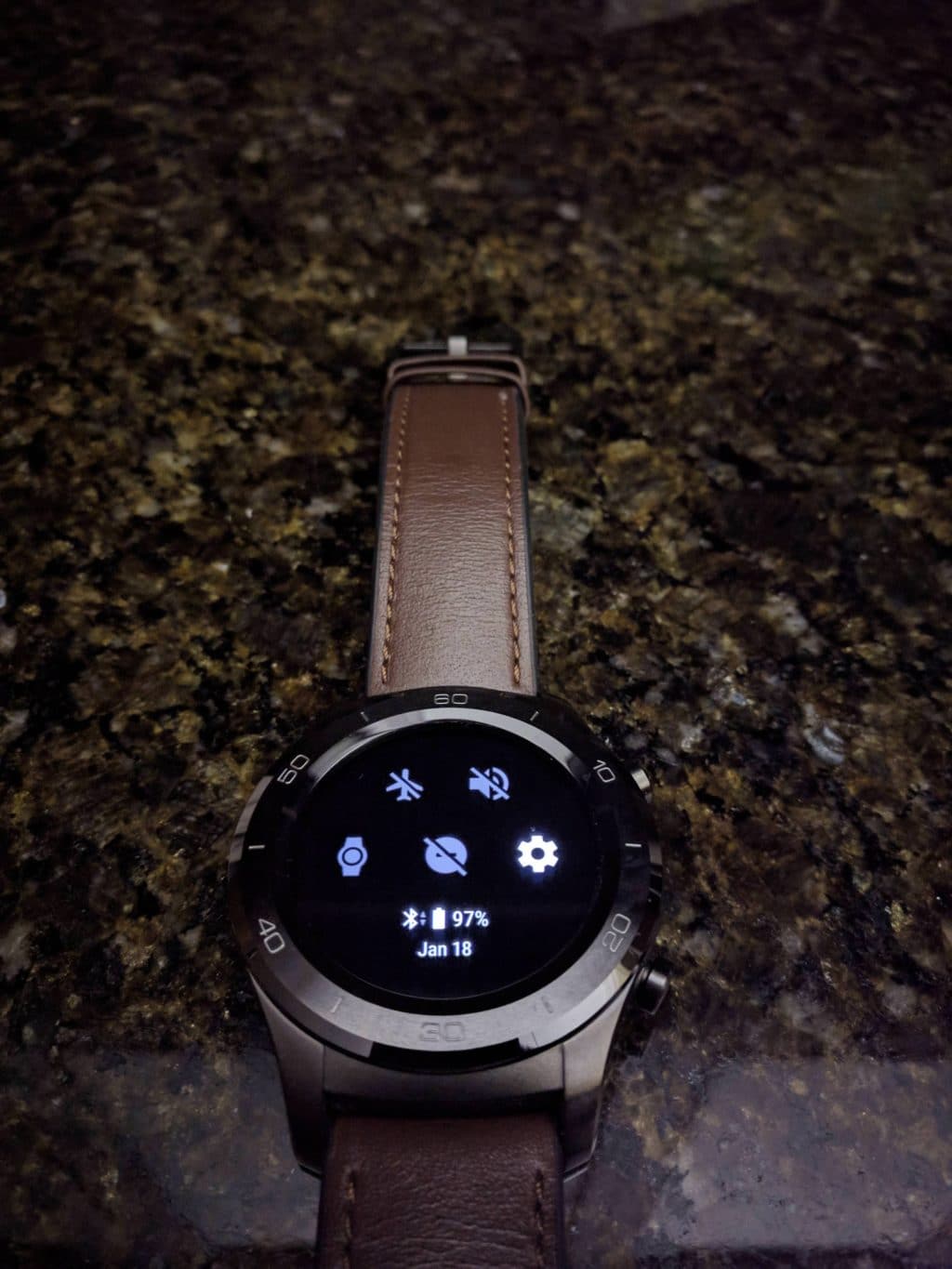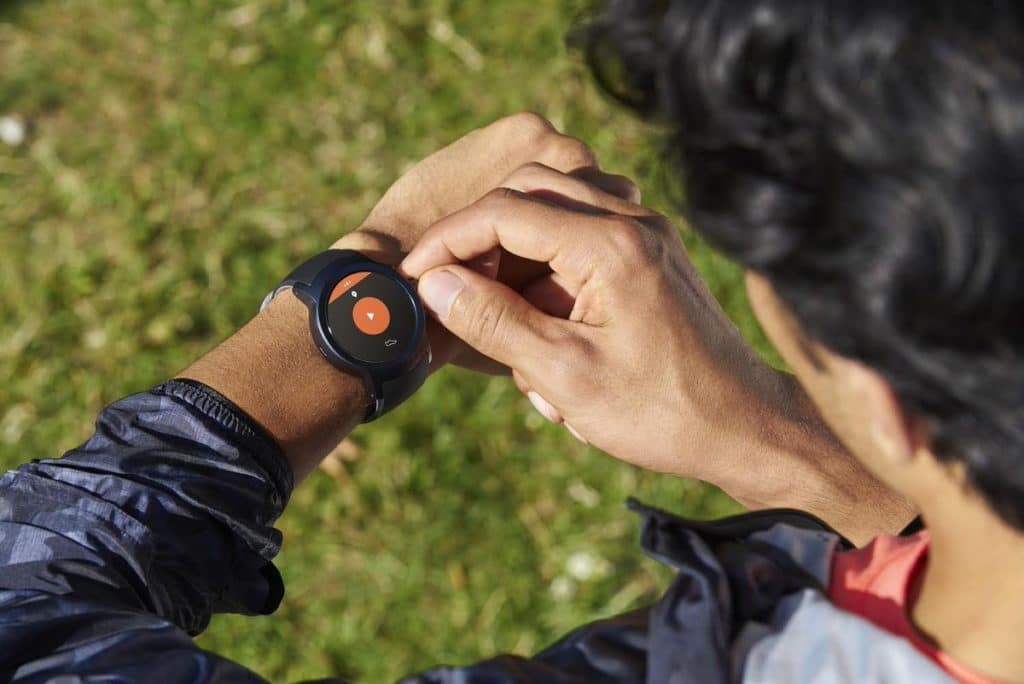The original LG G Watch, covered here, was clearly first generation hardware but still had its fans and attractions – and indeed Android Wear and its firmware has continued to improve. But we now have second generation hardware from LG… and, not to put too fine a point on it, the G Watch R is something of a kludged disaster of a design. And here’s why…
The point is perhaps made by looking at the G Watch R next to its predecessor. Yes, the new R (for ’round’) looks more like a traditional sports watch, but the older design looks more futuristic and, to be honest, a lot better fit for displaying Android notification information – aside from pure cosmetics, there really was no reason at all to use a circular interface.

The LG G Watch (original, screen off to save power!) and the G Watch R, showing an always on AMOLED clock variant….
Now, do please bear with me, since I’m not trying to be negative simply because I don’t like change and a circular screen is somehow new (it’s not, not least because the Moto 360 got there first, and did it better – don’t worry, I’ll explain below). And there are some plus points for the ‘R’ revision, which I’ll come to shortly. But the re-imagined G Watch isn’t exactly a leap forward overall for quite a number of reasons.
In no particular order:
- The watch itself is much larger in every dimension than the original G Watch – see the specs below and the photos on this page. I thought smartwatches were supposed to be getting smaller and thinner?
- Despite the above, the screen is smaller and shows quite a bit less information, some with edges ‘chopped off’ (thanks to the circular design).

I’m sorry, the watch part may work well in circular form, but other data is always going to struggle; compared to a rectangular display, bottom notification pop-ups have relatively little space to work in…
- The stop watch bezel is purely cosmetic (i.e. it doesn’t rotate) and is massive. The reason for its existence is something of a mystery. I’d thought that the display is really square (see the specs below) but with a circular viewport – and if you think about where the square’s corners might lie then you’ll instantly realise the possible purpose of all the super-bulky, non-functioning bezel. However, press shots from the watch’s launch show the screen to be circular, with electronics above and below, again prompting the question – why the huge circular bezel, i.e. all the way round?
- The display’s stats are also interesting in a disappointing way, as you’ll see from the specs table below, in that it’s higher resolution but physically quite a bit smaller. But why go down this route in the first place, when the older G Watch’s rectangular screen and smaller form factor made it much more suitable as a smartwatch?

That huge (in all three dimensions), almost completely functionless bezel
- The supplied strap is quite cheap ‘leather’, so it crinkles and cracks immediately, it’s definitely not fully waterproof (leather rarely is) and it feels rather cheap in the hand. To be fair, that’s a subjective opinion from me, and it’s easy to buy and install a replacement strap, but for this ‘premium’ product for LG to have skimped on the strap quality is arguably criminal.

The ‘Genuine Leather’ strap showing distress (or should that be ‘character’!) on day one…
- Bearing in mind the point above, and indeed the entire product, the LG G Watch R is far too expensive, at well over £200 in the UK. This is into ‘serious money’ territory, whereas the sweet spot for mass market adoption of smartwatches is around the £100/$100 mark, i.e. offer the G Watch R for £99 and it would take off. At the current price, and bearing in mind some of my comments here, this Android accessory hasn’t got a chance.
Of course, it’s not all bad news. You must be getting something for your (quite a lot of) money. The screen technology has been switched to AMOLED, meaning that a true always-on display can be achieved, by default a minimal variant on the watchface chosen by the user. This works really well and avoids having to either have the watch screen ‘on’ normally all the time or off completely until tapped or the right movement is detected, as on the original.

The AMOLED display does work very well, with a number of stunning watch faces…
Also new and working well is a ‘crown’, placed where a winding ‘movement’ would be on a traditional watch. Here it turns the display on fully or minimises it again or, when long pressed, brings up the elusive Android Wear Settings menu, which is a very handy shortcut.

The G Watch R’s ‘crown’, effectively a screen power and settings button….
| LG G Watch (original) | LG G Watch R | |
| Chipset, memory | Snapdragon 400, 4GB eMMC, 512MB RAM | Snapdragon 400, 4GB eMMC, 512MB RAM |
| Display | 1.65″ LCD IPS 280×280 | 1.3″ AMOLED, 320×320 (not all of which are visible) |
| Size | 38 x 46 x 10mm, 63g | 46 x 54 x 10mm, 62g |
| Battery | 400mAh | 410mAh |
| Strap | Silicone, waterproof | Leather |
Kudos to LG for the heart rate sensor, built into the G Watch R’s back. This uses a green LED and detector to look for pulses in blood flow beneath the skin of your wrist, and the resulting ten second reading (built into the watch menu system here) seems to be pretty accurate. As more Android applications are written to take advantage of the stats reported by the smartwatch, this extra sensor could be really useful and will certainly save you buying an extra heart sensor belt, for example.

The heart rate monitor works surprisingly well…
The charging cradle is similar to the original’s, with spring mounted pins and handy microUSB charger input. No complaints here and an advantage over other devices with proprietary charging cables (cough, Pebble), plus the latest Android Wear firmware does seem to pull in better battery life overall, I was easily getting two days of real world use from the G Watch R (ditto the original, by the way, with sensible brightness setting and latest firmware).

Charging contacts (why are there five?!) and heart rate sensor with green LED on the LG G Watch R…
As with the original LG G Watch, there’s no ambient light sensor, so you have to compromise on a brightness setting that will work for you in both daylight and at night – which can be awkward, especially in the middle of the night or at the cinema!
Are the innovations here enough to save the LG G Watch R overall? Not really, and especially not at this price. It really is a case of one step forward and two steps back – or three forwards and about six back, depending on how you’re counting. When the original G Watch appeared, I declared that I saw the idea as the future of wearables, even if the current implementation wasn’t perfect. And I’m still of this opinion – in fact, even more so, with this rather monstrous and expensive appendage.
Look, LG, just take the original G Watch design (and nice silicone strap), make the display AMOLED and add the ‘R’s heart rate sensor. And – most of all – use mass market economics to bring the cost down to £99 in the shops. THEN we’d see LG’s smart watch take off, THEN we’d see people wearing these things on buses and trains and in cars.
The future awaits LG and Android Wear – but it’s not here yet.
Thanks to the excellent Clove in the UK for the review hardware.










